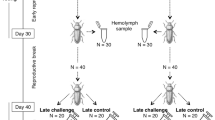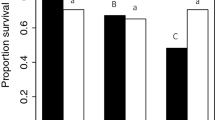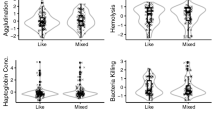Abstract
Immune-challenged vertebrate females transfer specific antibodies to their offspring1,2,3, but this gratuitous immunity cannot operate in invertebrates4. Here we show that constitutive immune defence is enhanced in sexual offspring of the bumble-bee Bombus terrestris L. when the parental colony is immune-challenged. Our findings indicate that invertebrates may use a different component of the immune system to generate a facultative trans-generational increase in the immune response.
Similar content being viewed by others
Main
Insect immunity is characterized by the inducible expression of a large array of antimicrobial peptides and by the constitutive melanization–encapsulation response, which is based on a cascade involving an inactive precursor of the enzyme phenol oxidase4,5. Antibacterial activity can be induced, for example, by lipopolysaccharide (LPS) extracted from bacterial surfaces. The operation of the cascade is indicated by the phenol oxidase activity in the insect haemolymph6,7 and can be monitored by measuring the rate of conversion of a phenol substrate into quinone, which then polymerizes to form melanin. Because both quinone and melanin are toxic to microorganisms5, hosts with high phenol oxidase activity are less susceptible to microbial infection8.
Social insects cooperate in brood care and make a considerable investment in their offspring. In annual species such as bumble-bees, reproduction occurs at the end of the colony cycle, when sexuals (daughter queens and males) emerge — here the term 'trans-generational' distinguishes the queen and workers from sexual offspring. Unlike daughter queens, males do not hibernate, so their reproductive success depends on post-emergence survival after they leave the parental colony and are exposed to parasites in the same habitat9. Assuming facultative adjustment of offspring immunity, we investigated whether parasite-challenged parental colonies could enhance their males' immunocompetence.
We used a split-colony design10 with 11 colonies, each equally split into treatment and control groups. In the immune-challenged group, 70–80% of workers were injected weekly with LPS (Sigma L-2755, 0.5 mg ml−1 in Ringer's solution (5 μl)), which activates the immune system for long periods11. Control workers were treated in the same way, but with the omission of LPS. Colonies completed their life cycle in the laboratory under standard conditions (24 °C, 60% relative humidity). We counted the number of sexuals and haemocytes (Neubauer haemocytometer, 1/6 dilution) and used standard protocols to measure antibacterial12 and phenol oxidase13 activity (1/20 dilution).
As expected, workers in the challenged groups showed more antibacterial activity than controls (Fig. 1). Their phenol oxidase activity, however, was lower (Fig. 1), indicating that there could be a possible trade-off between these two immune responses in challenged workers. Haemocyte counts were similar between the two groups (Wilcoxon's paired signed-rank test, T− = 29, n = 11, NS). Immune-challenged groups had lower reproductive output (repeated measures-MANOVA for log-transformed number of males and queens: Hotelling's T = 1.297, F2,9 = 5.839, P = 0.024), notably producing fewer queens (F1,10 = 12.082, P = 0.006), indicating a possible trade-off between reproductive output and immune response. Male offspring from challenged groups showed higher phenol oxidase activity than controls, but anti-bacterial activity (Fig. 1) and haemocyte counts were comparable between the two groups (T− = 29, n = 11, NS).
In workers, antibacterial activity was higher in challenged groups than in controls (Wilcoxon's paired signed-rank test: T+ = 6, n = 11, P < 0.02), but phenol oxidase activity was lower (T− = 3, n = 11, P = 0.005). In males, antibacterial activity was the same (T+ = 31, n = 11, NS) but phenol oxidase activity was higher (T+ = 6, n = 11, P < 0.02) in the challenged side than in controls. Further experiments showed that increased activity in males correlates with an increased encapsulation response against an invader (F1, 23 = 5.25, P = 0.031). Vmax is measured as the maximum change in optical density × 10−3 per minute.
As insects do not produce antibodies, they cannot transfer specific immunity as mammals do1. Male bumble-bees from immune-challenged groups have increased constitutive immunity relative to controls, which both enhances encapsulation (Fig. 1) and protects against microorganisms5,8. As the phenol oxidase enzyme cascade provides a broader immunity than the costly antibacterial immune response12, males may benefit by enhancing their most general means of prophylaxis. Although the physiological mechanism by which this trans-generational transfer is achieved is unknown, the enhanced immunity could be the result of monitoring cues from worker bees, as in the density-dependent prophylaxis observed in other insects13.
References
Hanson, L. A. Ann. Allergy Asthma Immunol. 81, 523–537 (1998).
Coste, A., Sirard, J. C., Johansen, K., Cohen, J. & Kraehenbuhl, J. P. J. Virol. 74, 8966–8971 (2000).
Rollier, C., Charollois, C., Jamard, C., Trepo, C. & Cova, L. Vaccine 18, 3091–3096 (2000).
Hoffmann, J. A., Reichhart, J. M. & Hetru, C. Curr. Opin. Immunol. 8, 8–13 (1996).
Söderhäll, K. & Cerenius, L. Curr. Opin. Immunol. 10, 23–28 (1998).
Nappi, A. J. & Vass, E. Pigment Cell Res. 6, 117–126 (1993).
Thörnqvist, P.-O. & Söderhäll, K. in Diseases in Asian Aquaculture vol. 3 (eds Flegel, T. W. & MacRae, I. H.) 203–218 (Fish Health Section, Asian Fisheries Soc., Manila, Philippines, 1996).
Nigam, Y., Maudlin, I., Welburn, S. & Rattcliffe, N. A. J. Invertebr. Pathol. 69, 279–281 (1997).
Schmid-Hempel, P. Parasites in Social Insects (Princeton Univ. Press, Princeton, New Jersey, 1998).
Schmid-Hempel, R. & Schmid-Hempel, P. Funct. Ecol. 12, 22–30 (1998).
Kato, Y. et al. Insect Biochem. Mol. Biol. 24, 539–545 (1994).
Moret, Y. & Schmid-Hempel, P. Science 290, 1166–1168 (2000).
Barnes, A. I. & Siva-Jothy, M. T. Proc. R. Soc. Lond. B 267, 177–182 (2000).
Author information
Authors and Affiliations
Corresponding author
Rights and permissions
About this article
Cite this article
Moret, Y., Schmid-Hempel, P. Immune defence in bumble-bee offspring. Nature 414, 506 (2001). https://doi.org/10.1038/35107138
Issue Date:
DOI: https://doi.org/10.1038/35107138
This article is cited by
-
Intersection between parental investment, transgenerational immunity, and termite sociality in the face of disease: a theoretical approach
Behavioral Ecology and Sociobiology (2022)
-
The effect of trematode infection on the markers of oxidative stress in the offspring of the freshwater snail Lymnaea stagnalis
Parasitology Research (2019)
-
Human activities might influence oncogenic processes in wild animal populations
Nature Ecology & Evolution (2018)
-
Innate immune memory: implications for development of pediatric immunomodulatory agents and adjuvanted vaccines
Pediatric Research (2014)
-
Genetic diversity and parasite prevalence in two species of bumblebee
Journal of Insect Conservation (2014)
Comments
By submitting a comment you agree to abide by our Terms and Community Guidelines. If you find something abusive or that does not comply with our terms or guidelines please flag it as inappropriate.




